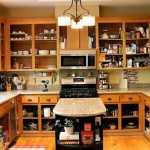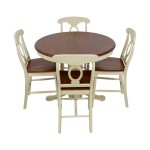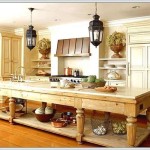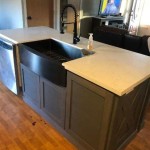How Much Does It Cost To Remodel a Small Kitchen?
Remodeling a kitchen, regardless of its size, represents a significant investment. However, the financial implications of a small kitchen remodel often differ substantially from those associated with larger, more complex renovations. Understanding the factors influencing cost is crucial for homeowners planning to upgrade their small kitchen without exceeding their budget. This article provides a comprehensive overview of the expenses involved in remodeling a small kitchen, allowing for more informed decision-making.
The cost of remodeling a small kitchen can vary widely, typically ranging from $5,000 to $30,000 or more. This wide range reflects the numerous variables at play, including the scope of the project, the quality of materials selected, and the labor costs in the homeowner's specific geographic location. A purely cosmetic refresh, such as painting cabinets and replacing hardware, will naturally be significantly less expensive than a complete gut renovation involving structural changes, new plumbing, and electrical work.
Key Factors Influencing the Cost of a Small Kitchen Remodel
Several interconnected factors contribute to the overall cost of a small kitchen remodel. Understanding these factors is essential for accurately estimating the project's financial implications and making informed decisions about where to allocate resources.
1. Scope of the Project: The scope of the project is arguably the most significant determinant of cost. A minor remodel, often referred to as a "facelift," might involve updating existing cabinets with fresh paint or new hardware, replacing countertops without altering the cabinet layout, installing a new backsplash, and upgrading the faucet and sink. These types of projects typically fall on the lower end of the cost spectrum. A mid-range remodel usually entails replacing cabinets and countertops, upgrading appliances, installing new flooring, and potentially reconfiguring the layout slightly. This type of project demands a greater investment. Finally, a major remodel or complete gut renovation involves tearing out all existing elements, potentially altering the kitchen's footprint, installing new plumbing and electrical systems, and selecting all new appliances, cabinets, countertops, flooring, and fixtures. This is the most expensive option.
The decision to alter the kitchen's layout fundamentally impacts the cost. Moving plumbing lines for a sink or dishwasher, or relocating electrical outlets and wiring for new appliances, requires specialized expertise and can significantly increase labor costs. Similarly, removing walls to expand the kitchen's footprint or create an open-concept design necessitates structural modifications that involve permits, inspections, and potentially the services of an architect or structural engineer.
2. Materials and Finishes: The selection of materials and finishes plays a vital role in determining the overall cost. Cabinets, countertops, flooring, appliances, and fixtures all come in a wide range of quality levels and price points. Stock cabinets, readily available at home improvement stores, are the most affordable option. Semi-custom cabinets offer more customization options and are typically moderately priced. Custom cabinets, built to specific dimensions and design preferences, are the most expensive choice.
Countertop materials range from laminate, the most budget-friendly option, to solid surface materials like Corian, quartz, granite, and marble, which represent a significant investment. The choice of flooring material similarly impacts the budget. Vinyl flooring is an inexpensive and durable option, while tile, hardwood, and engineered wood flooring command higher prices. Appliance packages vary considerably in cost, depending on brand, features, and energy efficiency. Stainless steel appliances are generally more expensive than white or black appliances. High-end appliances with advanced features, such as smart technology and integrated refrigeration, can significantly increase the project's overall cost. Careful consideration of material choices is crucial for balancing aesthetics, functionality, and budget constraints.
3. Labor Costs: Labor costs represent a substantial portion of the total remodeling expense. The cost of labor varies depending on the homeowner's geographic location, the contractor's experience and expertise, and the complexity of the project. Highly skilled and experienced contractors typically charge higher rates than less experienced or unlicensed contractors. However, hiring a qualified and reputable contractor is essential for ensuring the project is completed properly and to code. Obtaining multiple bids from different contractors is crucial for comparing prices and ensuring a competitive rate. The bids should include a detailed breakdown of all labor costs, including demolition, plumbing, electrical work, cabinet installation, countertop installation, flooring installation, and painting.
Permit fees also fall under the category of labor-related expenses. Building permits are often required for kitchen remodels, particularly those involving structural changes, plumbing, or electrical work. Permit fees vary depending on the municipality and the scope of the project. Failing to obtain the necessary permits can result in fines and delays. It's important to factor in the cost of permits when budgeting for the remodel.
Breaking Down the Budget: Common Cost Categories
To gain a clearer understanding of how the budget is allocated, it's helpful to examine the typical cost breakdown for a small kitchen remodel. While the specific percentages may vary depending on the project's scope and the homeowner's choices, the following provides a general guideline:
Cabinets: Cabinets typically account for the largest portion of the budget, often representing 30% to 40% of the total cost. The choice between stock, semi-custom, and custom cabinets significantly impacts this expense. Refacing existing cabinets, rather than replacing them, can be a cost-effective alternative.
Countertops: Countertops typically account for 10% to 20% of the budget. The material selection, such as laminate, solid surface, or natural stone, greatly influences the cost. The size and complexity of the countertop design also play a role.
Appliances: Appliances typically account for 10% to 20% of the budget. The brand, features, and energy efficiency of the appliances selected determine the cost. Purchasing an appliance package can sometimes offer cost savings.
Flooring: Flooring typically accounts for 5% to 10% of the budget. The choice between vinyl, tile, hardwood, or engineered wood flooring impacts the cost. The size of the kitchen and the complexity of the installation also contribute to the expense.
Plumbing: Plumbing typically accounts for 5% to 10% of the budget. This includes the cost of a new sink, faucet, and any necessary plumbing modifications. Moving plumbing lines can significantly increase this expense.
Electrical: Electrical work typically accounts for 5% to 10% of the budget. This includes the cost of new lighting fixtures, outlets, and any necessary electrical modifications. Adding new circuits or upgrading the electrical panel can increase this expense.
Backsplash: The backsplash typically accounts for 3% to 7% of the budget. The material selection, such as tile, glass, or stone, influences the cost. The size of the backsplash area and the complexity of the design also play a role.
Labor: Labor costs typically account for 20% to 35% of the budget. This includes the cost of demolition, plumbing, electrical work, cabinet installation, countertop installation, flooring installation, painting, and project management. The complexity of the project and the contractor's expertise influence this expense.
Strategies for Controlling Remodeling Costs
While remodeling a kitchen can be a significant investment, there are several strategies homeowners can employ to control costs without sacrificing quality or functionality.
Maintain the Existing Layout: Avoiding significant changes to the kitchen's layout is one of the most effective ways to save money. Moving plumbing lines and electrical outlets requires specialized expertise and can substantially increase labor costs. Keeping the sink, dishwasher, and appliances in their current locations minimizes the need for these costly modifications.
Reface Existing Cabinets: If the existing cabinet boxes are in good condition, refacing them instead of replacing them can save a significant amount of money. Refacing involves replacing the cabinet doors and drawer fronts with new ones and applying a matching veneer to the cabinet boxes. This can give the cabinets a fresh new look without the expense of replacing the entire cabinet system.
Opt for Stock or Semi-Custom Cabinets: Choosing stock or semi-custom cabinets instead of custom cabinets can result in substantial cost savings. Stock cabinets are readily available at home improvement stores and offer a limited range of sizes and styles. Semi-custom cabinets offer more customization options but are still less expensive than custom cabinets. Carefully planning the cabinet layout and selecting standard sizes can help minimize the need for custom cabinets.
Choose Cost-Effective Materials: Selecting more affordable materials for countertops, flooring, and backsplashes can significantly reduce the overall cost. Laminate countertops are a budget-friendly alternative to solid surface or natural stone countertops. Vinyl flooring is an inexpensive and durable option for flooring. Ceramic tile is a cost-effective option for backsplashes. Exploring different material options and comparing prices can help identify cost-saving opportunities.
DIY Some of the Work: Homeowners with the necessary skills and experience can save money by tackling some of the remodeling work themselves. Painting, demolition, and installing a backsplash are examples of tasks that can be completed by homeowners with basic DIY skills. However, it's important to be realistic about one's abilities and to avoid attempting tasks that require specialized expertise, such as plumbing or electrical work.
Shop Around for Appliances: Comparing prices from different retailers and looking for sales and discounts can help save money on appliances. Purchasing an appliance package can sometimes offer cost savings. Considering refurbished or open-box appliances can also be a budget-friendly option.
Get Multiple Bids: Obtaining multiple bids from different contractors is essential for ensuring a competitive rate. Carefully review each bid and compare the scope of work, materials, and labor costs. Don't automatically choose the lowest bid, as it may indicate lower quality workmanship or materials. Check references and reviews before hiring a contractor.
Plan Ahead and Avoid Changes: Making changes to the design or scope of the project after work has begun can lead to costly delays and additional expenses. Planning ahead and making all decisions before the project starts can help avoid these unexpected costs. Communicate clearly with the contractor about all design details and expectations.
By carefully considering these factors and implementing cost-saving strategies, homeowners can effectively manage the cost of remodeling a small kitchen and achieve their desired aesthetic and functional improvements. Thorough planning, realistic budgeting, and informed decision-making are key to a successful and affordable kitchen remodel.

Small Kitchen Remodel Cost Saving Tips Youtube

How Much Does A Small Kitchen Remodel Cost In 2024

Small Kitchen Remodel Cost Everything You Need To Know

Stunning Small Kitchen Makeover Under 1 000 The Power Of Paint

Small Kitchen Renovation And Design Ideas Hgtv

Small Kitchen Remodel Costs And Budgeting Explained

Remodel A Kitchen On Budget

How Much Does It Cost To Remodel A Kitchen

A Step By Breakdown Of Kitchen Remodeling Cost And Tips To Save Gbc Bath

Remodeling Tips For Small Kitchens O Hanlon Kitchen Bath
See Also








